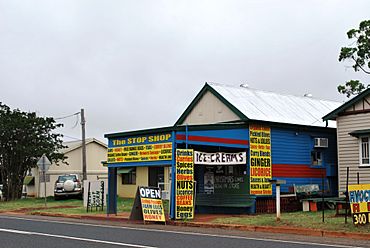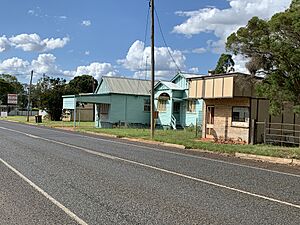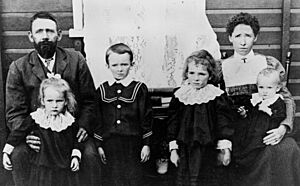Memerambi, Queensland facts for kids
Quick facts for kids MemerambiQueensland |
|||||||||||||||
|---|---|---|---|---|---|---|---|---|---|---|---|---|---|---|---|

The "Stop Shop"
|
|||||||||||||||
| Population | 338 (2021 census) | ||||||||||||||
| • Density | 11.01/km2 (28.5/sq mi) | ||||||||||||||
| Postcode(s) | 4610 | ||||||||||||||
| Area | 30.7 km2 (11.9 sq mi) | ||||||||||||||
| Time zone | AEST (UTC+10:00) | ||||||||||||||
| Location | |||||||||||||||
| LGA(s) | South Burnett Region | ||||||||||||||
| State electorate(s) | Nanango | ||||||||||||||
| Federal Division(s) | Maranoa | ||||||||||||||
|
|||||||||||||||
Memerambi is a small country town in Queensland, Australia. It's located in the South Burnett Region. In 2021, about 338 people lived in Memerambi.
Contents
Where is Memerambi?
Memerambi is about 239 kilometers (148 miles) northwest of Brisbane, the capital city of Queensland. The town is located right on the Bunya Highway.
A railway line, called the Nanango railway line, used to run near the highway. Memerambi had its own railway station. This part of the railway line closed down in 1964.
A Look at Memerambi's Past
The name Memerambi comes from an Aboriginal word. It means "sugargum tree."
How Memerambi Started
A surveyor named Hector Munro mapped out the town on May 7, 1904. Soon after, on October 17, 1904, the government started selling land in Memerambi. People could buy town lots and suburban lots.
The railway line from Murgon to Kingaroy opened on December 19, 1904. This made it easier for people to travel to and from Memerambi.
Schools and Churches
Memerambi Provisional School first opened its doors on October 16, 1905. It later became Memerambi State School in 1909. The school celebrated its 100th birthday in 2005. It closed down in 2007.
The Memerambi Methodist Church was built in 1908. It cost about £100 to build and could hold 100 people. This church was later moved to Corndale in 1956. All Saints' Anglican Church was also built in Memerambi in 1912 but closed around 1966.
Town Life in the Past
Memerambi was once a very busy place! It had a hotel, two general stores, a saddlery, a butcher, and even a bank. There was also a mobile sawmill and a factory that made cheese.
A postal office opened in Memerambi in 1909. The Memerambi Post Office then opened in September 1910 and stayed open until 1978.
Memerambi Today
Today, Memerambi still has some businesses. You can find the 'Stop Shop' general store there. Other businesses include clock repairs, large machinery and engineering works, and pharmaceutical manufacturing. There's also a stock feed store, graziers (people who raise livestock), and businesses for concreting and building swimming pools.
Learning in the Area
There are no schools directly in Memerambi now. Kids usually go to primary schools in nearby towns like Wooroolin or Crawford. For high school, students often attend Kingaroy State High School in Kingaroy.
Famous People from Memerambi
Mr. and Mrs. T.J. Kingston were the very first storekeepers in Memerambi.
Arthur Postle, also known as "The Crimson Flash," was a famous professional sprinter. In 1906, he was called "the fastest man in the world." He moved to Memerambi in 1913 and started his own auction business there.
Ben and Harry Young were brothers from Memerambi. They were important pioneers in the South Burnett peanut industry. In 1919, they planted the first commercial peanut crop in the area. Harry Young later designed the first machine to thresh peanuts in Queensland. Ben became a director of the Peanut Marketing Board, which helps peanut farmers.




